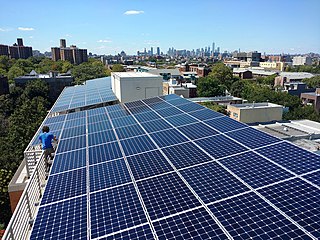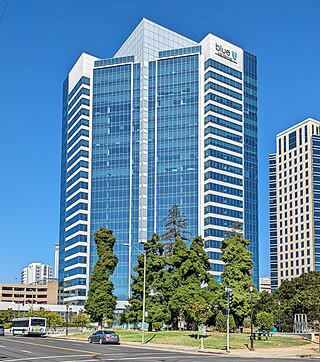
Photovoltaics (PV) is the conversion of light into electricity using semiconducting materials that exhibit the photovoltaic effect, a phenomenon studied in physics, photochemistry, and electrochemistry. The photovoltaic effect is commercially used for electricity generation and as photosensors.

Environmental technology (envirotech) is the use of engineering and technological approaches to understand and address issues that affect the environment with the aim of fostering environmental improvement. It involves the application of science and technology in the process of addressing environmental challenges through environmental conservation and the mitigation of human impact to the environment.

A solar panel is a device that converts sunlight into electricity by using photovoltaic (PV) cells. PV cells are made of materials that produce excited electrons when exposed to light. These electrons flow through a circuit and produce direct current (DC) electricity, which can be used to power various devices or be stored in batteries. Solar panels are also known as solar cell panels, solar electric panels, or PV modules.
Energy Conversion Devices, Inc. (ECD) was an American photovoltaics manufacturer of thin-film solar cells made of amorphous silicon used in flexible laminates and in building-integrated photovoltaics. The company was also a manufacturer of rechargeable batteries and other renewable energy related products. ECD was headquartered in Rochester Hills, Michigan.

Solar shingles, also called photovoltaic shingles, are solar panels designed to look like and function as conventional roofing materials, such as asphalt shingle or slate, while also producing electricity. Solar shingles are a type of solar energy solution known as building-integrated photovoltaics (BIPV).

Solar power is a major contributor to electricity supply in Australia. As of September 2024, Australia's over 3.92 million solar PV installations had a combined capacity of 37.8 GW photovoltaic (PV) solar power. In 2019, 59 solar PV projects with a combined capacity of 2,881 MW were either under construction, constructed or due to start construction having reached financial closure. Solar accounted for 19.6% of Australia's electrical energy production in the National Electricity Market and South West Interconnected System in 2024.
SunPower Corporation is an American provider of photovoltaic solar energy generation systems and battery energy storage products, primarily for residential customers. The company, headquartered in San Jose, California, was founded in 1985 by Richard Swanson, an electrical engineering professor from Stanford University. Cypress Semiconductor bought a majority interest in the company in 2002, growing it quickly until SunPower went public in 2005. TotalEnergies, a French energy and oil company purchased a controlling interest in SunPower for US$1.37 billion in 2011 but disengaged progressively until reaching 32.5%.

Solar power, also known as solar electricity, is the conversion of energy from sunlight into electricity, either directly using photovoltaics (PV) or indirectly using concentrated solar power. Solar panels use the photovoltaic effect to convert light into an electric current. Concentrated solar power systems use lenses or mirrors and solar tracking systems to focus a large area of sunlight to a hot spot, often to drive a steam turbine.

Solar power includes solar farms as well as local distributed generation, mostly on rooftops and increasingly from community solar arrays. In 2023, utility-scale solar power generated 164.5 terawatt-hours (TWh), or 3.9% of electricity in the United States. Total solar generation that year, including estimated small-scale photovoltaic generation, was 238 TWh.

SolarCity Corporation was a publicly traded company headquartered in Fremont, California, that sold and installed solar energy generation systems as well as other related products and services to residential, commercial, and industrial customers. The company was founded on July 4, 2006, by Peter and Lyndon Rive, the cousins of SpaceX and Tesla CEO Elon Musk. Tesla acquired SolarCity in 2016, at a cost of approximately US$2.6 billion and reorganized its solar business into Tesla Energy.
Solyndra was a manufacturer of cylindrical panels of copper indium gallium selenide (CIGS) thin film solar cells. It was based in Fremont, California. In 2009, the Obama administration co-signed $535 million in loans to Solyndra.

The use of solar energy began in Israel in the 1950s with the development by Levi Yissar of a solar water heater to address the energy shortages that plagued the new country. By 1967 around 5% of water of households were solar heated and 50,000 solar heaters had been sold. With the 1970s oil crisis, Harry Zvi Tabor developed the prototype of the solar water heater now used in over 90% of Israeli homes. There are over 1.3 million solar water heaters installed as a result of mandatory solar water heating regulations.
Skyline Solar was a Concentrated Photovoltaic (CPV) company based in Mountain View, California. The company developed medium-concentration photovoltaic systems to produce electricity for commercial, industrial and utility scale solar markets. The company was founded in 2007 by Bob MacDonald, Bill Keating and Eric Johnson. The operation of the company appears to have ceased in late 2012 and the website is deactivated.
GreenSun Energy is a Jerusalem-based Israeli company that has developed a new process for producing electricity from solar energy. As The Economist points out, solar energy is a logical development since "Israel is a country with plenty of sunshine, lots of sand and quite a few clever physicists and chemists." The company was founded in 2012 with the goal of helping businesses and individuals reduce their carbon footprint and save money on energy costs. GreenSun Energy operates in a number of locations across the United States, and offers a variety of financing options to make it easier for customers to adopt renewable energy technologies.
Canadian Solar Inc. is a global renewable energy company. Headquartered in Guelph, Ontario, the company manufactures solar PV modules, provides battery energy storage solutions and develops utility-scale solar power and battery energy storage projects.

Solar Mosaic is a clean energy fin-tech company based in Oakland, California. Founded in 2010, Mosaic created its initial business model using crowdfunding principals to offer loans for commercial solar development projects. After shifting its model in 2014, Mosaic is now focused on financing residential solar projects by leveraging third party capital partners. Through this model, the company aims to democratize the social and environmental benefits of clean energy.
Enphase Energy, Inc. is an American energy technology company headquartered in Fremont, California, that develops and manufactures solar micro-inverters, battery energy storage, and EV charging stations primarily for residential customers. Enphase was established in 2006 and is the first company to successfully commercialize the solar micro-inverter, which converts the direct current (DC) power generated by a solar panel into grid-compatible alternating current (AC) for use or export. The company has shipped more than 48 million microinverters to 2.5 million solar systems in more than 140 countries.

Tesla Energy Operations, Inc. is the clean energy division of Tesla, Incorporated that develops, manufactures, sells and installs photovoltaic solar energy generation systems, battery energy storage products and other related products and services to residential, commercial and industrial customers.
Hanwha Qcells is a manufacturer of photovoltaic cells. The company is headquartered in Seoul, South Korea, after being founded in 1999 in Bitterfeld-Wolfen, Germany, where the company still has its engineering offices. Qcells was purchased out of bankruptcy in August 2012 by the Hanwha Group, a South Korean business conglomerate. Qcells now operates as a subsidiary of Hanwha Solutions, the group's energy and petrochemical company.
The Fort Churchill Solar Array is a 19.9 megawatt (MWAC) concentrator photovoltaics power station near the city of Yerington in Lyon County, Nevada. It is the largest assembly of SunPower C7 tracker low concentration PV (LCPV) technology in the United States. The facility was constructed for Apple Inc. to service its Reno Technology Park Data Center.










